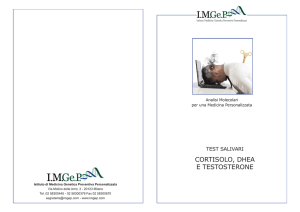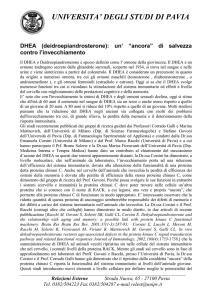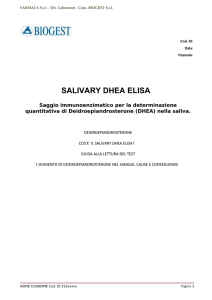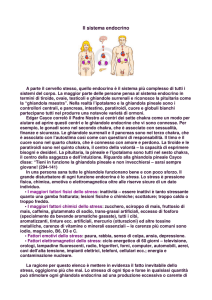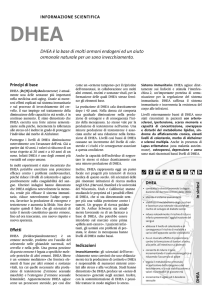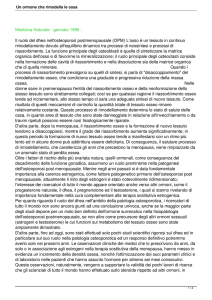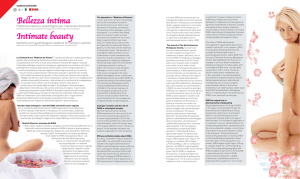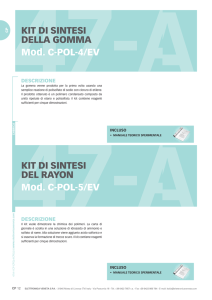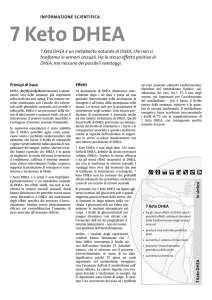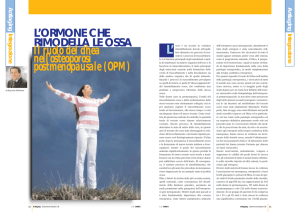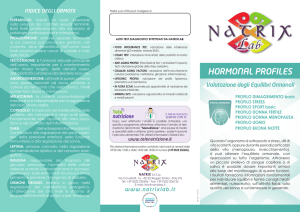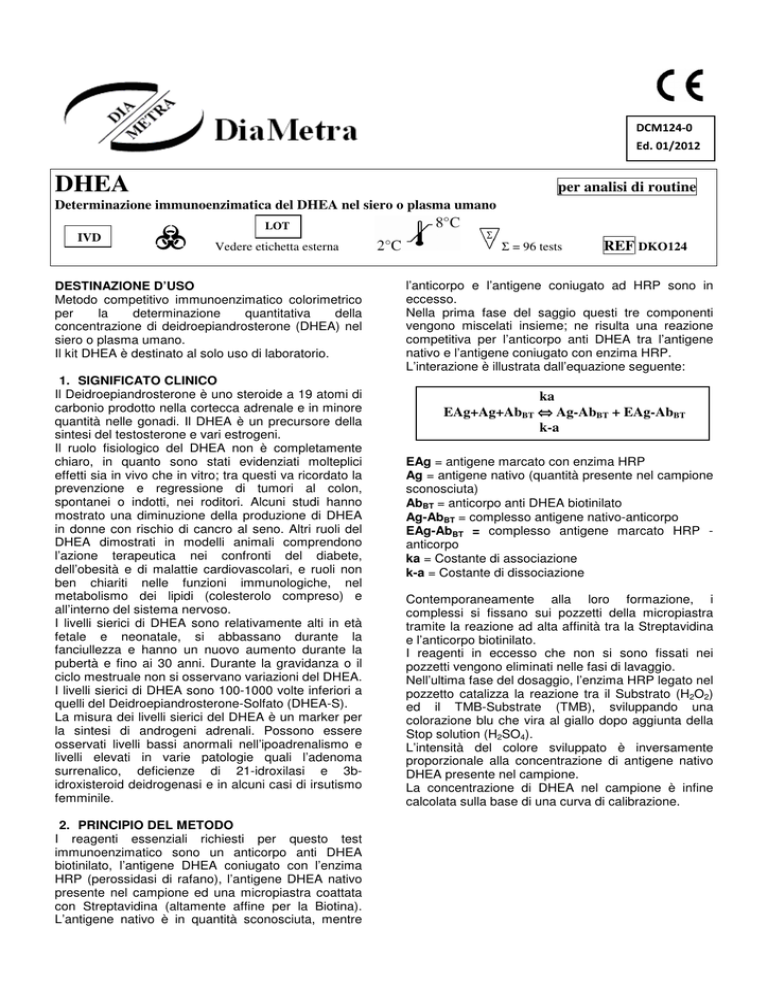
DCM124-0
Ed. 01/2012
DHEA
per analisi di routine
Determinazione immunoenzimatica del DHEA nel siero o plasma umano
LOT
IVD
Vedere etichetta esterna
DESTINAZIONE D’USO
Metodo competitivo immunoenzimatico colorimetrico
per
la
determinazione
quantitativa
della
concentrazione di deidroepiandrosterone (DHEA) nel
siero o plasma umano.
Il kit DHEA è destinato al solo uso di laboratorio.
1. SIGNIFICATO CLINICO
Il Deidroepiandrosterone è uno steroide a 19 atomi di
carbonio prodotto nella cortecca adrenale e in minore
quantità nelle gonadi. Il DHEA è un precursore della
sintesi del testosterone e vari estrogeni.
Il ruolo fisiologico del DHEA non è completamente
chiaro, in quanto sono stati evidenziati molteplici
effetti sia in vivo che in vitro; tra questi va ricordato la
prevenzione e regressione di tumori al colon,
spontanei o indotti, nei roditori. Alcuni studi hanno
mostrato una diminuzione della produzione di DHEA
in donne con rischio di cancro al seno. Altri ruoli del
DHEA dimostrati in modelli animali comprendono
l’azione terapeutica nei confronti del diabete,
dell’obesità e di malattie cardiovascolari, e ruoli non
ben chiariti nelle funzioni immunologiche, nel
metabolismo dei lipidi (colesterolo compreso) e
all’interno del sistema nervoso.
I livelli sierici di DHEA sono relativamente alti in età
fetale e neonatale, si abbassano durante la
fanciullezza e hanno un nuovo aumento durante la
pubertà e fino ai 30 anni. Durante la gravidanza o il
ciclo mestruale non si osservano variazioni del DHEA.
I livelli sierici di DHEA sono 100-1000 volte inferiori a
quelli del Deidroepiandrosterone-Solfato (DHEA-S).
La misura dei livelli sierici del DHEA è un marker per
la sintesi di androgeni adrenali. Possono essere
osservati livelli bassi anormali nell’ipoadrenalismo e
livelli elevati in varie patologie quali l’adenoma
surrenalico, deficienze di 21-idroxilasi e 3bidroxisteroid deidrogenasi e in alcuni casi di irsutismo
femminile.
2. PRINCIPIO DEL METODO
I reagenti essenziali richiesti per questo test
immunoenzimatico sono un anticorpo anti DHEA
biotinilato, l’antigene DHEA coniugato con l’enzima
HRP (perossidasi di rafano), l’antigene DHEA nativo
presente nel campione ed una micropiastra coattata
con Streptavidina (altamente affine per la Biotina).
L’antigene nativo è in quantità sconosciuta, mentre
Σ = 96 tests
REF DKO124
l’anticorpo e l’antigene coniugato ad HRP sono in
eccesso.
Nella prima fase del saggio questi tre componenti
vengono miscelati insieme; ne risulta una reazione
competitiva per l’anticorpo anti DHEA tra l’antigene
nativo e l’antigene coniugato con enzima HRP.
L’interazione è illustrata dall’equazione seguente:
ka
EAg+Ag+AbBT ⇔ Ag-AbBT + EAg-AbBT
k-a
EAg = antigene marcato con enzima HRP
Ag = antigene nativo (quantità presente nel campione
sconosciuta)
AbBT = anticorpo anti DHEA biotinilato
Ag-AbBT = complesso antigene nativo-anticorpo
EAg-AbBT = complesso antigene marcato HRP anticorpo
ka = Costante di associazione
k-a = Costante di dissociazione
Contemporaneamente alla loro formazione, i
complessi si fissano sui pozzetti della micropiastra
tramite la reazione ad alta affinità tra la Streptavidina
e l’anticorpo biotinilato.
I reagenti in eccesso che non si sono fissati nei
pozzetti vengono eliminati nelle fasi di lavaggio.
Nell’ultima fase del dosaggio, l’enzima HRP legato nel
pozzetto catalizza la reazione tra il Substrato (H2O2)
ed il TMB-Substrate (TMB), sviluppando una
colorazione blu che vira al giallo dopo aggiunta della
Stop solution (H2SO4).
L’intensità del colore sviluppato è inversamente
proporzionale alla concentrazione di antigene nativo
DHEA presente nel campione.
La concentrazione di DHEA nel campione è infine
calcolata sulla base di una curva di calibrazione.
3. REATTIVI, MATERIALI E STRUMENTAZIONE
3.1. Reattivi e materiali forniti nel kit
1. DHEA Calibrators (6 flaconi, 1 mL ciascuno)
CAL0
REF DCE002/12406-0
CAL1
REF DCE002/12407-0
CAL2
REF DCE002/12408-0
CAL3
REF DCE002/12409-0
CAL4
REF DCE002/12410-0
CAL5
REF DCE002/12411-0
2. DHEA Enzyme Reagent (1 flacone, 6 mL)
DHEA coniugato con perossidasi di rafano (HRP)
REF DCE002/12402-0
3. DHEA Biotin Reagent (1 flacone, 6 mL)
Anticorpo anti DHEA biotinilato
REF DCE019/12419-0
4. Coated Microplate (1 micropiastra breakable)
Micropiastra coattata con Streptavidina
REF DCE002/12403-0
5. TMB Substrate (1 flacone, 12 mL)
H2O2 -TMB (0,26 g/L) (evitare il contatto con la pelle)
REF DCE004/12404-0
6. Stop Solution (1 flacone, 8 mL)
Acido Solforico 0,15 mol/L (evitare il contatto con la
pelle)
REF DCE005/12405-0
7. 50X Conc. Wash Solution (1 flacone, 20 mL)
NaCl 45 g/L; Tween-20 55 g/L REF DCE006/12406-0
3.2. Reattivi necessari non forniti nel kit
Acqua distillata.
3.3. Materiale ausiliario e strumentazione
Dispensatori automatici.
Lettore per micropiastre (450 nm).
Note
Conservare tutti i reattivi a 2÷8°C, al riparo dalla
luce.
Aprire la busta del Reattivo 4 (Coated Microplate)
solo dopo averla riportata a temperatura ambiente e
chiuderla subito dopo il prelievo delle strip da
utilizzare.
4. AVVERTENZE
Questo test kit è per uso in vitro, da eseguire da
parte di personale esperto. Non per uso interno o
esterno su esseri Umani o Animali.
• Usare i previsti dispositivi di protezione individuale
mentre si lavora con i reagenti forniti.
• Seguire le Buone Pratiche di Laboratorio (GLP)
per la manipolazione di prodotti derivati da
sangue.
• Tutti i reattivi di origine umana usati nella
preparazione dei reagenti sono stati testati e sono
risultati negativi per la presenza di anticorpi antiHIV 1&2, per HbsAg e per anticorpi anti-HCV.
Tuttavia nessun test offre la certezza completa
dell’assenza di HIV, HBV, HCV o di altri agenti
infettivi. Pertanto, i Calibratori devono essere
maneggiati come materiali potenzialmente infettivi.
•
•
•
•
•
Alcuni reagenti contengono piccole quantità di
R
Proclin 300 come conservante. Evitare il contatto
con la pelle e le mucose.
Il TMB Substrato contiene un irritante, che può
essere dannoso se inalato, ingerito o assorbito
attraverso la cute. Per prevenire lesioni, evitare
l’inalazione, l’ingestione o il contatto con la cute e
con gli occhi.
La Stop Solution è costituita da una soluzione di
acido solforico diluito. L’acido solforico è velenoso
e corrosivo e può essere tossico se ingerito. Per
prevenire possibili ustioni chimiche, evitare il
contatto con la cute e con gli occhi.
Evitare l’esposizione del reagente TMB/H2O2 a
luce solare diretta, metalli o ossidanti. Non
congelare la soluzione.
5. PRECAUZIONI
Si prega di attenersi rigorosamente alla sequenza
dei passaggi indicata in questo protocollo. I
risultati presentati qui sono stati ottenuti usando
specifici reagenti elencati in queste Istruzioni per
l’Uso.
• Tutti i reattivi devono essere conservati a
temperatura controllata di 2-8°C nei loro
contenitori originali. Eventuali eccezioni sono
chiaramente indicate. I reagenti sono stabili fino
alla data di scadenza se conservati e trattati
seguendo le istruzioni fornite.
• Prima dell’uso lasciare tutti i componenti dei kit e i
campioni a temperatura ambiente (22-28°C) e
mescolare accuratamente.
• Non scambiare componenti dei kit di lotti diversi.
Devono essere osservate le date di scadenza
riportate sulle etichette della scatola e di tutte le
fiale. Non utilizzare componenti oltre la data di
scadenza.
• Qualora si utilizzi strumentazione automatica, è
responsabilità dell’utilizzatore assicurarsi che il kit
sia stato opportunamente validato.
• Un lavaggio incompleto o non accurato dei
pozzetti può causare una scarsa precisione e/o
un’elevato background.
• Per la riproducibilità dei risultati, è importante che
il tempo di reazione di ogni pozzetto sia lo stesso.
Per evitare il time shifting durante la
dispensazione degli reagenti, il tempo di
dispensazione dei pozzetti non dovrebbe
estendersi oltre i 10 minuti. Se si protrae oltre, si
raccomanda di seguire lo stesso ordine di
dispensazione. Se si utilizza più di una piastra, si
raccomanda di ripetere la curva di calibrazione in
ogni piastra.
• L’addizione del TMB Substrato dà inizio ad una
reazione cinetica, la quale termina con l’addizione
della Stop Solution. L’addizione del TMB Substrato
e della Stop Solution deve avvenire nella stessa
sequenza per evitare tempi di reazione differenti.
• Osservare le linee guida per l’esecuzione del
controllo di qualità nei laboratori clinici testando
controlli e/o pool di sieri.
• Osservare
la
massima
precisione
nella
ricostituzione e dispensazione dei reagenti.
• Non
usare
campioni
microbiologicamente
contaminati, altamente lipemici o emolizzati.
•
•
I lettori di micropiastre leggono l’assorbanza
verticalmente. Non toccare il fondo dei pozzetti.
6. PROCEDIMENTO
6.1. Preparazione dei Calibratori (C0…C5)
I Calibratori sono pronti all’uso ed hanno le seguenti
concentrazioni di Deidroepiandrosterone:
ng/mL
C0
0
C1
0,5
C2
2,0
C3
5,0
C4
10,0
C5
30,0
Una volta aperti sono stabili per 6 mesi a 2÷8°C.
6.2. Preparazione del Campione
La determinazione del Deidroepiandrosterone può
essere effettuata su plasma o siero umano. Se il
dosaggio non viene effettuato lo stesso giorno del
prelievo conservare il campione a -20°C. Evitare cicli
di congelamento e scongelamento del campione.
6.3. Preparazione della Wash Solution
Prima dell’uso, diluire il contenuto di ogni fiala di “50X
Conc. Wash Solution” con acqua distillata fino al
volume di 1000 mL. Per preparare volumi minori
rispettare il rapporto di diluizione di 1:50. La soluzione
di lavaggio diluita è stabile a 2÷8°C per almeno 30
giorni.
6.4. Procedimento
Portare tutti i reagenti a temperatura ambiente
(22-28°C).
• Le strisce di pozzetti non utilizzate devono essere
rimesse immediatamente nella busta richiudibile
contenente il materiale essicante e conservate a
2-8°C.
• Per evitare potenziali contaminazioni microbiche
e/o chimiche non rimettere i reagenti inutilizzati nei
flaconi originali
• Al fine di aumentare l’accuratezza dei risultati del
test è necessario operare in doppio, allestendo
due pozzetti per ogni punto della curva di
calibrazione (C0-C5), due per ogni Controllo, due
per ogni Campione ed uno per il Bianco.
•
Reagente
Calibratore
Calibratore
C0-C5
25 µL
Campione
DHEA
Enzyme
Reagent
Campione
Bianco
25 µL
50 µL
50 µL
Agitare delicatamente la micropiastra per 20-30
secondi per miscelare bene la soluzione.
DHEA
Biotin
Reagent
50 µL
50 µL
Agitare delicatamente la micropiastra per 20-30
secondi per miscelare bene la soluzione. Coprire la
micropiastra
Incubare 1 h a temperatura ambiente (22-28°C).
Allontanare la miscela di reazione; lavare i pozzetti 3
volte con 350 µL di wash solution diluita.
TMB
Substrate
100 µL
100 µL
Incubare 20 minuti a temperatura
(22÷28°C), al riparo dalla luce.
Stop
Solution
50 µL
50 µL
100 µL
ambiente
50 µL
Agitare delicatamente la micropiastra.
Leggere l’assorbanza (E) a 450 nm contro il Bianco.
7. CONTROLLO QUALITA’
Ogni laboratorio dovrebbe analizzare i campioni nella
gamma dei livelli elevati, normali e bassi di DHEA per
il controllo delle prestazioni dell’analisi. Questi
campioni dovrebbero essere trattati come ignoti ed i
valori determinati in ogni test effettuato. Le tabelle di
controllo qualità dovrebbero essere effettuate per
seguire le prestazioni dei reagenti forniti. Metodi
statistici adeguati dovrebbero essere impiegati per
accertare il trend. Il laboratorio dovrebbe fissare i
limiti di accettabilità di prestazioni dell’analisi. Altri
parametri che dovrebbero essere controllati includono
le intercette di 80, 50 e 20% della curva standard per
valutare la riproducibilità. In più, la capacità di
assorbimento massima dovrebbe essere costante
con l’esperienza precedente. La deviazione
significativa dalle prestazioni stabilite può indicare il
cambiamento inosservato negli stati o nella
degradazione sperimentali dei reagenti del kit.
Reagenti freschi dovrebbero essere usati per
determinare il motivo delle variazioni.
7.1. Interpretazione dei risultati
Se per calcolare i risultati è stato usato il computer, è
imperativo che i valori dei calibratori cadano entro il
10% delle concentrazioni assegnate.
8. RISULTATI
8.1. Estinzione media
Calcolare l’estinzione media (Em) di ciascun punto
della curva di calibrazione (C0-C5) e di ogni campione.
8.2. Curva di calibrazione
Tracciare sul grafico delle assorbanze i valori calcolati
delle estinzioni medie (Em) di ciascun calibratore (C0C5) in funzione delle concentrazioni. Tracciare la
miglior curva passante per i punti di calibrazione (es:
Four Parameter Logistic).
8.3 Calcolo dei risultati
Interpolare, dal grafico, i valori di assorbanza relativi a
ciascun campione e leggerne la corrispondente
concentrazione in ng/mL
9. VALORI DI RIFERIMENTO
Le concentrazioni seriche o plasmatiche di
Deidroepiandrosterone sono comprese nei seguenti
intervalli:
Range (ng/mL)
Femmine
1,3 - 9,8
Maschi
1,8 - 12,5
È importante tenere presente che la determinazione
di un range di valori attesi in un dato metodo per una
popolazione “normale” è dipendente da molteplici
fattori, quali la specificità e sensibilità del metodo in
uso, e la popolazione in esame. Perciò ogni
laboratorio dovrebbe considerare i range indicati dal
Fabbricante come un’indicazione generale e produrre
range di valori attesi propri basati sulla popolazione
indigena dove il laboratorio risiede.
10. PARAMETRI CARATTERISTICI
10.1. Precisione
10.1.1. Intra-Assay
La variabilità all’interno dello stesso kit è stata
determinata replicando la misura di tre differenti sieri
di controllo. La variabilità intra-assay è ≤ 9,8%.
10.1.2. Inter-Assay
La variabilità tra kit differenti è stata determinata
replicando la misura di tre differenti sieri di controllo
con kit appartenenti a lotti diversi. La variabilità interassay è ≤ 10,7%.
10.2. Sensibilità
La concentrazione minima di DHEA misurabile che
può essere distinta dal Calibratore 0 è 0,10 ng/mL
con un limite di confidenza del 95%.
10.3. Specificità
L’anticorpo impiegato presenta le seguenti reazioni
crociate, calcolate al 50% secondo Abraham:
Substance
%
DHEA
100
DHEA-S
0,004
Androstenedione
0,056
Corticosterone
0,004
Cortisolo
0,001
Pregnenolone
0,070
Testosterone
0,002
Dihydrotestosterone
0,007
Estriolo
< 0,001
Estradiolo
< 0,001
Estrone
< 0,001
11. DISPOSIZIONI PER LO SMALTIMENTO
I reagenti devono essere smaltiti in accordo con le
leggi locali.
BIBLIOGRAFIA
1. Dorfman RI, Shipley, RA, Adrogens, John Wiley
and Sons, New York, 1956, pp. 116-128.
2. Pang S, Riddick L, Hirsutism, IN Lifshitz (ed),
Pediatric Endocrinology, A Clinical Guide, second
edition, Marcel Dekker Inc., New York 1990, pp
259-291
3. De Peretti E, Forest MG, Pattern of plasma
dehydroepiandrosterone sulfate levels ih humans
from birth to adulthood: evidence for testicular
production, J Clin Endocrinol Metab, 47, 572-577
(1978)
4. Lashansky G, Saenger P, Fishman K, Gautier T,
Mayes D, Berg G, Di Martino-Nardi J, Reiter E,
Normative data for adrenal steroidogenesis in a
healthy pediatric population: age and sex-related
changes after adrenocorticotropin stimulation, J
Clin Endocrinol Metab, 73, 674-686 (1991)
5. Zurnoff B, Roenfeld RS, Stain GW, Levin J,
Fukushima DK, Sex differences in twenty-four
hour mean plasma concentration of dehydroepiandrosterone (DHEA) and dehydroepiandrosterone
sulfate (DHEAS) and the DHEA to DHEAS ratio in
normal adults, J Clin Endocrinol Metab 51, 330333 (1980)
6. Pang S, Lerner A, Stoner E, Oberfield S, Engle I,
New M, Late-onset adrenal steroid 3’hydroxysteroid dehydrogenase deficiency: a cause
of hirsutism in pubertal and postpubertal women, J
Clin Endocrinol Metab 60, 428-439 (1985)
7. Lee PDK, Winter RJ, and Gree OC, Virilizing
adrenocortical tumors in childhood: eight cases
and a review of the literature, Pediatrics, 76, 437444 (1985)
nd
8. Tietz NW, Textbook of clinical chemistry, 2 ed.
Philadelphia WB Saunders, 1994
Ed. 01/2012
DCM124-0
DiaMetra S.r.l. Headquater: Via Garibaldi, 18 –
20090 SEGRATE (MI) Italy
Tel. 0039-02-2139184 – 02-26921595
Fax 0039–02–2133354.
Manufactory: Via Giustozzi, 35/35a – Z.I Paciana –
06034 FOLIGNO (PG) Italy
Tel. 0039-0742–24851
Fax 0039–0742–316197
E-mail: [email protected]
DCM124-0
Ed. 01/2012
DHEA
for routine analysis
Immunoenzymatic determination of DHEA in human serum or plasma
IVD
LOT
See external label
Σ = 96 tests
REF DKO124
INTENDED USE
Competitive immunoenzymatic colorimetric method for
quantitative determination of Dehydroepiandrosterone
(DHEA) concentration in human serum or plasma.
DHEA kit is intended for laboratory use only.
The interaction is illustrated by the following equation:
1. CLINICAL SIGNIFICANCE
Dehydroepiandrosterone (DHEA) is a C19 steroid
secreted by the adrenal cortex and in smaller quantities
by the gonads. DHEA is a precursor in testosterone and
various estrogens biosynthesis.
The physiologic role of DHEA is not-well defined,
because of a lot of ascertained in vivo and in vitro
effects, for example the prevention and regression of
colon tumor, spontaneous and inducted, in rodents.
Some studies showed a decrease in the DHEA
production in women with risk for the breast cancer. In
animal models DHEA showed a role in the therapeutic
action against diabetes, obesity and cardiovascular
pathologies, and unclear roles in immunology, in lipid
metabolism (also cholesterol) and in the nervous
system.
Seric levels of DHEA are relatively high in fetal and
neonatal age, decrease during childhood and increase
again during puberty until 30 years. No DHEA variations
have been observed during pregnancy or menstrual
cycle. Seric levels of DHEA are 100-1000 times lower
than the levels of DHEA sulphate (DHEA-S).
The measurement of seric levels of DHEA is a marker
for adrenal androgen synthesis. Abnormal low levels of
DHEA can be observed in the hypoadrenalism, while
elevated levels can be observed in various pathologies
such as the surrenalic adenomas, 21-hydroxylase and
3b-hydroxysteroid dehydrogenase deficiency and in
some cases of female hirsutism.
EAg = antigen linked to HRP enzyme
Ag = native antigen (unknown amount in the sample)
AbBT = biotinylated anti DHEA antibody
Ag-AbBT = native antigen-antibody complex
EAg-AbBT = native antigen linked to HRP - antibody
complex
ka = rate constant of association
k-a = rate constant of dissociation
2. PRINCIPLE OF THE METHOD
The
essential
reagents
required
for
this
immunoenzymatic assay are a biotinylated anti DHEA
antibody,
the DHEA antigen conjugated with the
enzyme HRP (horseradish peroxidase), the DHEA
antigen present in the sample, and a microplate coated
with Streptavidin (highly specific for Biotin). The quantity
of native antigen is unknown, while the antibody and the
antigen linked to HRP are in excess.
In the first part of the assay these three components are
mixed together; a competitive reaction for the anti
DHEA antibody between the native antigen and the
antigen linked to HRP develops.
ka
EAg+Ag+AbBT ⇔ Ag-AbBT + EAg-AbBT
k-a
Simultaneously to their formation, the complexes are
fixed to the microplate wells through the interaction
between the Streptavidin and the biotinylated
antibody.
The reagents in excess that have not react are
eliminated in the washing steps.
In the last part of the assay, the enzyme HRP linked
in the wells reacts with the Substrate (H2O2) and the
TMB Substrate and develops a blu color that changes
into yellow when the Stop Solution (H2SO4) is added.
The colour intensity is inversely proportional to the
native antigen DHEA in the sample.
DHEA concentration in the sample is finally calculated
through a calibration curve.
3. REAGENTS, MATERIALS AND INSTRUMENTATION
3.1. Reagents and materials supplied in the kit
1. DHEA Calibrators (6 vials, 1 mL each)
REF DCE002/12406-0
CAL0
CAL1
REF DCE002/12407-0
CAL2
REF DCE002/12408-0
CAL3
REF DCE002/12409-0
CAL4
REF DCE002/12410-0
CAL5
REF DCE002/12411-0
2. DHEA Enzyme Reagent (1 vial, 6 mL)
DHEA conjugated with horseradish peroxydase (HRP)
REF DCE002/12402-0
3. DHEA Biotin Reagent (1 vial, 6 mL)
Antibody anti DHEA biotinylated
REF DCE019/12419-0
4. Coated Microplate (1 breakable microplate)
Microplate coated with Streptavidin
REF DCE002/12403-0
5. TMB Substrate (1 vial, 12 mL)
H2O2-TMB 0.26 g/L (avoid any skin contact)
REF DCE004/12404-0
6. Stop Solution (1 vial, 8 mL)
Sulphuric acid 0.15 mol/L (avoid any skin contact)
REF DCE005/12405-0
7. 50X Conc. Wash Solution (1 vial, 20 mL)
NaCl 45 g/L; Tween-20 55 g/L
REF DCE006/12406-0
3.2. Reagents necessary not supplied
Distilled water.
3.3. Auxiliary materials and instrumentation
Automatic dispenser.
Microplates reader (450 nm)
Notes
Store all reagents between 2÷ 8°C in the dark.
Open the bag of reagent 4 (Coated Microplate) only
when it is at room temperature and close it
immediately after use.
4. WARNINGS
This kit is intended for in vitro use by professional
persons only. Not for internal or external use in
Humans or Animals.
• Use appropriate personal protective equipment while
working with the reagents provided.
• Follow Good Laboratory Practice (GLP) for handling
blood products.
• All human source material used in the preparation of
reagents has been tested and found negative for
antibody to HIV 1&2, HbsAg, and HCV. No test
method however can offer complete assurance that
HIV, HBV, HCV or other infectious agents are
absent. Therefore, the Calibrators should be handled
in the same manner as potentially infectious
material.
• Some reagents contain small amounts of Proclin
R
300 as preservative. Avoid the contact with skin or
mucosa.
•
•
•
•
The TMB Substrate contains an irritant, which may
be harmful if inhaled, ingested or absorbed
through the skin. To prevent injury, avoid
inhalation, ingestion or contact with skin and eyes.
The Stop Solution consists of a diluted sulphuric
acid solution. Sulphuric acid is poisonous and
corrosive and can be toxic if ingested. To prevent
chemical burns, avoid contact with skin and eyes.
Avoid the exposure of reagent TMB/H2O2 to
directed sunlight, metals or oxidants. Do not freeze
the solution.
5. PRECAUTIONS
• Please adhere strictly to the sequence of pipetting
steps provided in this protocol. The performance
data represented here were obtained using
specific reagents listed in this Instruction For Use.
• All reagents should be stored refrigerated at 2-8°C
in their original container. Any exceptions are
clearly indicated. The reagents are stable until the
expiry date when stored and handled as indicated.
• Allow all kit components and specimens to reach
room temperature (22-28°C) and mix well prior to
use.
• Do not interchange kit components from different
lots. The expiry date printed on box and vials
labels must be observed. Do not use any kit
component beyond their expiry date.
• If you use automated equipment, the user has the
responsibility to make sure that the kit has been
appropriately tested.
• The incomplete or inaccurate liquid removal from
the wells could influence the assay precision
and/or increase the background.
• It is important that the time of reaction in each well
is held constant for reproducible results. Pipetting
of samples should not extend beyond ten minutes
to avoid assay drift. If more than 10 minutes are
needed, follow the same order of dispensation. If
more than one plate is used, it is recommended to
repeat the dose response curve in each plate
• Addition of the TMB Substrate solution initiates a
kinetic reaction, which is terminated by the
addition of the Stop Solution. Therefore, the TMB
Substrate and the Stop Solution should be added
in the same sequence to eliminate any time
deviation during the reaction.
• Observe the guidelines for performing quality
control in medical laboratories by assaying
controls and/or pooled sera.
• Maximum precision is required for reconstitution
and dispensation of reagents.
• Samples microbiologically contaminated, highly
lipemeic or haemolysed should not be used in the
assay.
• Plate readers measure vertically. Do not touch the
bottom of the wells.
6. PROCEDURE
6.1. Preparation of Calibrators (C0…C5)
The Calibrators are ready for use and have the following
concentration of DHEA:
ng/mL
C0
0
C1
0,5
C2
2,0
C3
5,0
C4
10,0
C5
30,0
Once opened, the Calibrators are stable for 6 months at
2÷8°C.
6.2. Preparation of the Sample
The determination of Dehydroepiandrosterone can be
performed in human plasma as well as in serum of
patients.
Store the sample at -20°C if the determination is not
performed on the same day of the sample connection.
Avoid repetitive freezing and thawing of samples.
6.3. Preparation of Wash Solution
Dilute the content of each vial of the “50X Conc. Wash
Solution” with distilled water to a final volume of 1000
mL prior to use. For smaller volumes respect the 1:50
dilution ratio. The diluted wash solution is stable for 30
days at 2÷8°C.
6.4. PROCEDURE
Allow all reagents to reach room temperature
(22-28°C).
• Unused coated microwell strips should be released
securely in the foil pouch containing desiccant and
stored at 2-8°C.
• To avoid potential microbial and/or chemical
contamination, unused reagents should never be
transferred into the original vials.
• As it is necessary to perform the determination in
duplicate in order to improve accuracy of the test
results, prepare two wells for each point of the
calibration curve (C0-C5), two for each Control, two for
each sample, one for Blank.
•
Reagent
Calibrator
C0-C5
Calibrator
Blank
25 µL
Sample
DHEA
Enzyme
Reagent
Sample
25 µL
50 µL
50 µL
Shake gently the microplate for 20-30 seconds to
mix.
DHEA
Biotin
Reagent
50 µL
50 µL
Shake gently the microplate for 20-30 seconds to
mix. Cover the plate.
Incubate 1 h at room temperature (22-28°C).
Remove the contents from each well; wash the wells
3 times with 350 µL of diluted Wash Solution.
TMB
Substrate
100 µL
100 µL
100 µL
Incubate 20 minutes at room temperature (22÷28°C),
in the dark.
Stop
Solution
50 µL
50 µL
50 µL
Shake gently the micoplate.
Read the absorbance (E) at 450 nm against blank.
7. QUALITY CONTROL
Each laboratory should assay controls at normal, high
and low levels range of DHEA for monitoring assay
performance. These controls should be treated as
unknowns and values determined in every test
procedure performed. Quality control charts should be
maintained to follow the performance of the supplied
reagents. Pertinent statistical methods should be
employed to ascertain trends. The individual
laboratory should set acceptable assay performance
limits. Other parameters that should be monitored
include the 80, 50 and 20% intercepts of the standard
curve for run-to-run reproducibility. In addition,
maximum absorbance should be consistent with past
experience. Significant deviation from established
performance can indicate unnoticed change in
experimental conditions or degradation of kit
reagents.
Fresh reagents should be used to
determine the reason for the variations.
7.1. Interpretation of Results
If computer controlled data reduction is used to
calculate the results of the test, it is imperative that
the predicted values for the calibrators fall within 10%
of the assigned concentrations.
8. RESULTS
8.1. Mean Absorbance
Calculate the mean of the absorbances (Em) for each
point of the calibration curve (C0-C5) and of each
sample.
8.2. Calibration Curve
Plot the values of absorbance (Em) of the calibrators
(C0-C5) against concentration.
Draw the best-fit curve through the plotted points(es:
Four Parameter Logistic).
8.3. Calculation of Results
Interpolate the values of the samples on the
calibration curve to obtain the corresponding values of
the concentrations expressed in ng/mL.
9. REFERECE VALUES
The serum or plasma
reference values are:
Range (ng/mL)
Dehydroepiandrosterone
Female
1,3 - 9,8
Male
1,8 - 12,5
Please pay attention to the fact that the determination of
a range of expected values for a “normal” population in
a given method is dependent on many factors, such as
specificity and sensitivity of the method used and type of
population under investigation. Therefore each
laboratory should consider the range given by the
Manufacurer as a general indication and produce their
own range of expected values based on the indigenous
population where the laboratory works.
10. PERFORMANCE AND CHARACTERISTICS
10.1. Precision
10.1.1. Intra-Assay Variation
Within run variation was determined by replicate the
measurement of three different control sera in one
assay. The within assay variability is ≤ 9,8%.
10.1.2. Inter-Assay Variation
Between run variation was determined by replicate the
measurement of three different control sera in different
lots. The between assay variability is ≤ 10,7%.
10.2. Sensitivity
The lowest detectable concentration of DHEA that can
be distinguished from the Calibrator 0 is 0,10 ng/mL at
the 95% confidence limit.
10.3. Specificity
The cross reaction of the antibody calculated at 50%
according to Abraham are shown in the table:
Substance
%
DHEA
100
DHEA-S
0,004
Androstenedione
0,056
Corticosterone
0,004
Cortisol
0,001
Pregnenolone
0,070
Testosterone
0,002
Dihydrotestosterone
0,007
Estriol
< 0,001
Estradiol
< 0,001
Estrone
< 0,001
11. WASTE MENAGEMANT
Reagents must be disposed off in accordance with local
regulations.
BIBLIOGRAPHY
1. Dorfman RI, Shipley, RA, Adrogens, John Wiley
and Sons, New York, 1956, pp. 116-128.
2. Pang S, Riddick L, Hirsutism, IN Lifshitz (ed),
Pediatric Endocrinology, A Clinical Guide, second
edition, Marcel Dekker Inc., New York 1990, pp
259-291
3. De Peretti E, Forest MG, Pattern of plasma
dehydroepiandrosterone sulfate levels ih humans
from birth to adulthood: evidence for testicular
production, J Clin Endocrinol Metab, 47, 572-577
(1978)
4. Lashansky G, Saenger P, Fishman K, Gautier T,
Mayes D, Berg G, Di Martino-Nardi J, Reiter E,
Normative data for adrenal steroidogenesis in a
healthy pediatric population: age and sex-related
changes after adrenocorticotropin stimulation, J
Clin Endocrinol Metab, 73, 674-686 (1991)
5. Zurnoff B, Roenfeld RS, Stain GW, Levin J,
Fukushima DK, Sex differences in twenty-four
hour mean plasma concentration of dehydroepiandrosterone (DHEA) and dehydroepiandrosterone
sulfate (DHEAS) and the DHEA to DHEAS ratio in
normal adults, J Clin Endocrinol Metab 51, 330333 (1980)
6. Pang S, Lerner A, Stoner E, Oberfield S, Engle I,
New M, Late-onset adrenal steroid 3’hydroxysteroid dehydrogenase deficiency: a cause
of hirsutism in pubertal and postpubertal women, J
Clin Endocrinol Metab 60, 428-439 (1985)
7. Lee PDK, Winter RJ, and Gree OC, Virilizing
adrenocortical tumors in childhood: eight cases
and a review of the literature, Pediatrics, 76, 437444 (1985)
nd
8. Tietz NW, Textbook of clinical chemistry, 2 ed.
Philadelphia WB Saunders, 1994
Ed. 01/2012
DCM124-0
DiaMetra S.r.l. Headquater: Via Garibaldi, 18 –
20090 SEGRATE (MI) Italy
Tel. 0039-02-2139184 – 02-26921595 – Fax 0039–
02–2133354.
Manufactory: Via Giustozzi, 35/35a – Z.I Paciana –
06034 FOLIGNO (PG) Italy
Tel. 0039-0742–24851 Fax 0039–0742–316197
E-mail: [email protected]
DIA.METRA SRL
Mod. PIS
IT
PACKAGING INFORMATION SHEET
Spiegazione dei simboli
DE
FR
ES
Explication des symboles
Significado de los simbolos
PT
Verwendete Symbole
REF
yyyy-mm-dd
Σ = xx
Max
Min
GB
Explanation of symbols
Explicaçao dos simbolos
DE
ES
FR
GB
IT
PT
In vitro Diagnostikum
Producto sanitario para diagnóstico In vitro
Dispositif medical de diagnostic in vitro
In vitro Diagnostic Medical Device
Dispositivo medico-diagnostico in vitro
Dispositivos medicos de diagnostico in vitro
DE
ES
FR
GB
IT
PT
Hergestellt von
Elaborado por
Fabriqué par
Manufacturer
Produttore
Produzido por
DE
ES
FR
GB
IT
PT
Bestellnummer
Nûmero de catálogo
Réferéncès du catalogue
Catalogue number
Numero di Catalogo
Número do catálogo
DE
ES
FR
GB
IT
PT
Herstellungs datum
Fecha de fabricacion
Date de fabrication
Date of manufacture
Data di produzione
Data de produção
DE
ES
FR
GB
IT
PT
Verwendbar bis
Establa hasta (usar antes de último día del mes)
Utiliser avant (dernier jour du mois indiqué)
Use by (last day of the month)
Utilizzare prima del (ultimo giorno del mese)
Utilizar (antes ultimo dia do mês)
DE
ES
FR
GB
IT
PT
Biogefährdung
Riesco biológico
Risque biologique
Biological risk
Rischio biologico
Risco biológico
DE
ES
FR
GB
IT
PT
Gebrauchsanweisung beachten
Consultar las instrucciones
Consulter le mode d’emploi
Consult instructions for use
Consultare le istruzioni per l’uso
Consultar instruções para uso
DE
ES
FR
GB
IT
PT
Chargenbezeichnung
Codigo de lote
Numero de lot
Batch code
Codice del lotto
Codigo do lote
DE
ES
FR
GB
IT
PT
Ausreichend für “n” Tests
Contenido suficiente para ”n” tests
Contenu suffisant pour “n” tests
Contains sufficient for “n” tests
Contenuto sufficiente per “n” saggi
Contém o suficiente para “n” testes
DE
ES
FR
GB
IT
PT
Inhalt
Contenido del estuche
Contenu du coffret
Contents of kit
Contenuto del kit
Conteúdo do kit
DE
ES
FR
GB
IT
PT
Temperaturbereich
Límitaciôn de temperatura
Limites de température de conservation
Temperature limitation
Limiti di temperatura
Temperaturas limites de conservação
yyyy-mm
Cont.
DIA.METRA SRL
Mod. PIS
PACKAGING INFORMATION SHEET
SUGGERIMENTI PER LA RISOLUZIONE DEI PROBLEMI/TROUBLESHOOTING
ERRORE CAUSE POSSIBILI/ SUGGERIMENTI
Nessuna reazione colorimetrica del saggio
- mancata dispensazione del coniugato
- contaminazione del coniugato e/o del Substrato
- errori nell’esecuzione del saggio (es. Dispensazione accidentale dei reagenti in sequenza errata o provenienti da
flaconi sbagliati, etc.)
Reazione troppo blanda (OD troppo basse)
- coniugato non idoneo (es. non proveniente dal kit originale)
- tempo di incubazione troppo breve, temperatura di incubazione troppa bassa
Reazione troppo intensa (OD troppo alte)
- coniugato non idoneo (es. non proveniente dal kit originale)
- tempo di incubazione troppo lungo, temperatura di incubazione troppa alta
- qualità scadente dell’acqua usata per la soluzione di lavaggio (basso grado di deionizzazione)
- lavaggi insufficienti (coniugato non completamente rimosso)
Valori inspiegabilmente fuori scala
- contaminazione di pipette, puntali o contenitori- lavaggi insufficienti (coniugato non completamente rimosso)
CV% intrasaggio elevato
- reagenti e/o strip non portate a temperature ambiente prima dell’uso
- il lavatore per micropiastre non lava correttamente (suggerimento: pulire la testa del lavatore)
CV% intersaggio elevato
- condizioni di incubazione non costanti (tempo o temperatura)
- controlli e campioni non dispensati allo stesso tempo (con gli stessi intervalli) (controllare la sequenza di
dispensazione)
- variabilità intrinseca degli operatori
ERROR POSSIBLE CAUSES / SUGGESTIONS
No colorimetric reaction
- no conjugate pipetted reaction after addition
- contamination of conjugates and/or of substrate
- errors in performing the assay procedure (e.g. accidental pipetting of reagents in a wrong sequence or from the
wrong vial, etc.)
Too low reaction (too low ODs)
- incorrect conjugate (e.g. not from original kit)
- incubation time too short, incubation temperature too low
Too high reaction (too high ODs)
- incorrect conjugate (e.g. not from original kit)
- incubation time too long, incubation temperature too high
- water quality for wash buffer insufficient (low grade of deionization)
- insufficient washing (conjugates not properly removed)
Unexplainable outliers
- contamination of pipettes, tips or containers
insufficient washing (conjugates not properly removed) too high within-run
- reagents and/or strips not pre-warmed to CV% Room Temperature prior to use
- plate washer is not washing correctly (suggestion: clean washer head)
too high between-run - incubation conditions not constant (time, CV % temperature)
- controls and samples not dispensed at the same time (with the same intervals) (check pipetting order)
- person-related variation

